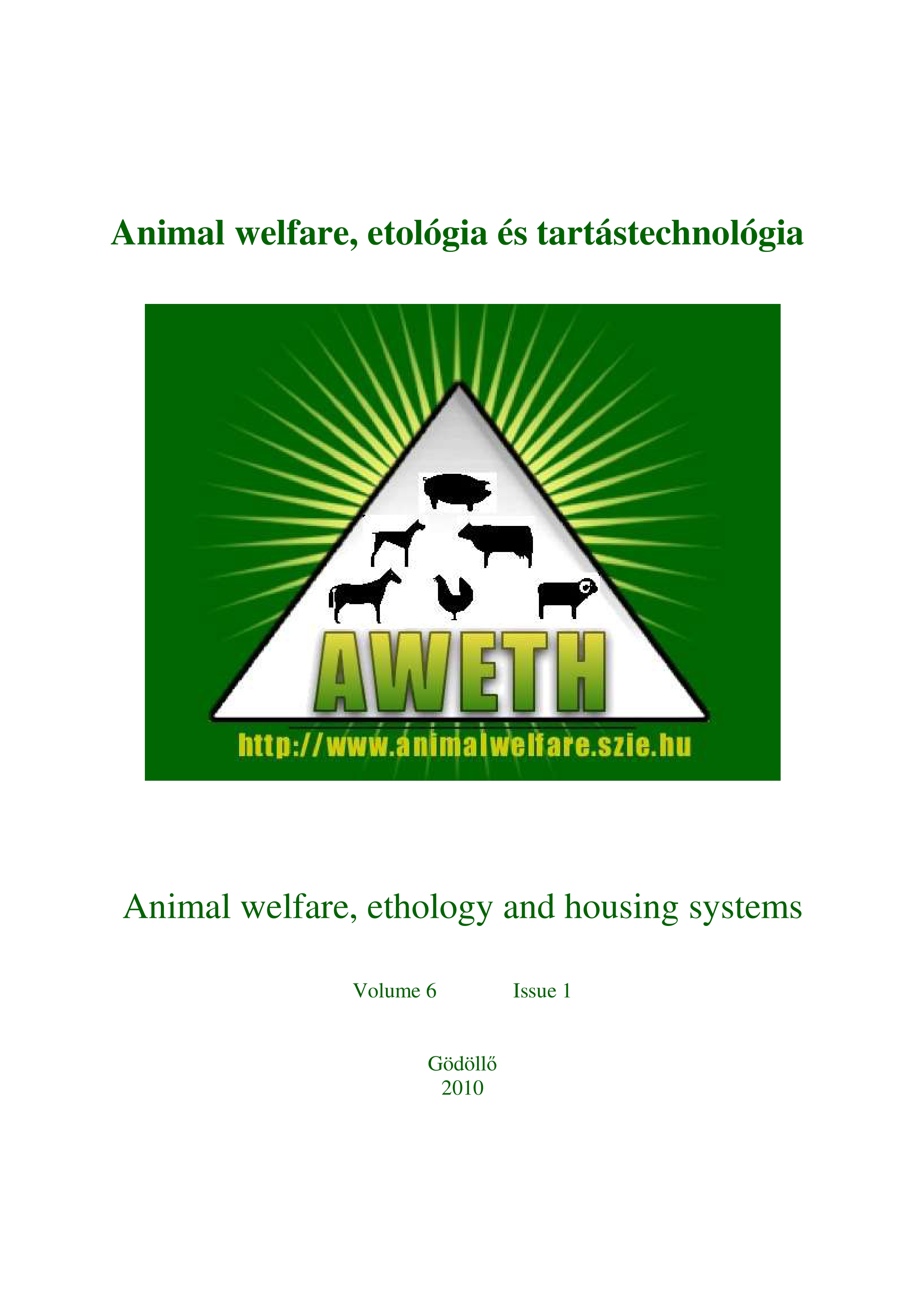A környezetgazdagítás hatása a mókusmajmokra és a gyűrűsfarkú makikra a Miskolci Állatkert és Kultúrparkban
Kulcsszavak:
környezetgazdagítás, mókusmajom, gyűrűsfarkú maki, Miskolci ÁllatkertAbsztrakt
Célunk a környezetgazdagítás hatásának vizsgálata volt a Miskolci Állatkert kis mókusmajom és gyűrűsfarkú maki csapatára. A gazdagítás során több módszert is alkalmaztunk. Az első időszakban a táplálkozási időt próbáltuk megnövelni mesterséges etetők kihelyezésével, egy későbbi időszakban pedig az aktivitásukat játékok segítségével szerettük volna fokozni. Az eredmények kiértékelése után megállapítható, hogy a mókusmajmok és a katták esetében is az egyedek viselkedése megváltozott a környezetgazdagítás hatására. A mókusmajmok többet mozogtak (helyváltoztatás), és a szociális kapcsolatok száma is emelkedett náluk. A kattáknál a táplálék kereseséssel töltött idő megemelkedett gazdagítás következtében.
Hivatkozások
Baumans, V. (2005): Environmental Enrichment for Laboratory Rodents and Rabbits: Requirements of Rodents, Rabbits, and Research. ILAR Journal, 46(2) 162–170. https://doi.org/10.1093/ilar.46.2.162
Boere, V. (2001): Environmental enrichment for neotropical primates in captivity. Cienc. Rural, 31(3) https://doi.org/10.1590/S0103-84782001000300031
Carlstead, K.; Shepherdson, D. (1994): Effects of environmental enrichment on reproduction. Zoo Biology, 13(5) 447–458. https://doi.org/10.1002/zoo.1430130507
Chapman, J. (2005): What is enrichment? Regional Environmental Enrichment Conferences.
Clubb, R., Mason, G. J. (2007): Natural behavioural biology as a risk factor in carnivore welfare: How analysing species differences could help zoos improve enclosures. Applied Animal Behaviour Science, 102(3–4) 303–328. https://doi.org/10.1016/j.applanim.2006.05.033
Grandin, T. (1988): Environmental enrichment for confinement pigs. Livestock Conservation Institute, Proceedings of the 1988 Annual Meeting, Kansas City, Missouri.
Honess, P. E., Marin, C. M. (2006): Enrichment and aggression in primates. Neuroscience and biobehavioral reviews, 30(3) 413–436. https://doi.org/10.1016/j.neubiorev.2005.05.002
Hosey, G. R. (1997): Behavioural research in zoos: Academic perspectives. Applied Animal Behaviour Science, 51(3–4) 199–207. https://doi.org/10.1016/S0168-1591(96)01104-5
Izzo, G. N. (2007): The effects of multilevel enrichment on behaviors indicating distress and well-being in captive Squirrel monkeys (Saimiri sciureus). Submitted April 11, 2007 in partial fulfillment of the requirement for a B.A. in Psychology at Franklin & Marshall College.
Lukas, K.E., Hoff, M.P., Maple, T.L. (2003) [in Tarou & Bashaw, 2007]: Gorilla behavior in response to systematic alternation between zoo enclosures. Applied Animal Behaviour Science, 81(4) 367–386. https://doi.org/10.1016/S0168-1591(02)00237-X
Lutz, C. K. & Novak, M. A. (2005): Environmental Enrichment for Nonhuman Primates: Theory and Application; ILAR Journal, 46(2) 178–191. https://doi.org/10.1093/ilar.46.2.178
Maki, S., Bloomsmith, M.A., (1989) [in Tarou & Bashaw, 2007]: Uprooted trees facilitate the psychological well-being of captive chimpanzees. Zoo Biology, 8(1) 79–87. https://doi.org/10.1002/zoo.1430080110
Markowitz, H., Schmidt, M. J., Moody, A. (1978): Behavioural engineering and animal health in the zoo. International Zoo Yearbook., 18(1) 190–194. https://doi.org/10.1111/j.1748-1090.1978.tb00256.x
Mason, G.; Clubb, R.; Latham, N.; Vickery, S. (2007): Why and how should we use environmental enrichment to tackle stereotypic behaviour? Applied Animal Behaviour Science, 102(3–4) 163–188. https://doi.org/10.1016/j.applanim.2006.05.041
Newberry, R. C. (1995): Environmental enrichment: Increasing the biological relevance of captive environments. Applied Animal Behaviour Science, 44(2–4) 229–243. https://doi.org/10.1016/0168-1591(95)00616-Z
Pies-Schulz-Hofen, R. (2000): Az állatkerti állattartás alapjai. Magyar Állatkertek Szövetsége és a Fővárosi Állat- és Növénykert.
Redshaw, M. E., Mallinson J. J. C. (1991): Learning from the wild: Improving the pshychological and physiological well-being of captive primates. Dodo, 27:18–26.
Shepherdson, D. J. (1993) [in Carlstead & Shepherson 1994]: The role of environmental enrichment int he breeding and reintroduction of endangered species. pp. 167–177 in Creative Conservation: Interactive Management of wild and captive animals. P. j. Olney; G. Mace; A. Feistner, eds. London, Chapman & Hall. https://doi.org/10.1007/978-94-011-0721-1_8
Tarou, L.R., Bashaw, M.J. (2003): Maximizing the effectiveness of environmental enrichment: Suggestions from the experimental analysis of behavior. Applied Animal Behaviour Science, 102(3–4) 189–204. https://doi.org/10.1016/j.applanim.2006.05.026
Vick, S., Anderson, J.R., Young, R. (2000) [in Tarou & Bashaw, 2007]: Maracas for Macaca? Evaluation of three potential enrichment objects in two species of zoo-housed macaques. Zoo Biology, 19(3) 181–191. https://doi.org/10.1002/1098-2361(2000)19:3<181::AID-ZOO2>3.0.CO;2-W
Letöltések
Megjelent
Folyóirat szám
Rovat
License
Copyright (c) 2010 Kövi Gabriella, Tóthné Maros Katalin

This work is licensed under a Creative Commons Attribution-NonCommercial-NoDerivatives 4.0 International License.
A folyóirat a nyílt hozzáférés elvei szerint működik, cikkeire ugyanakkor a Creative Commons 4.0 standard licenc alábbi típusa vonatkozik: CC-BY-NC-ND-4.0. Ennek értelmében a mű szabadon másolható, terjeszthető, bemutatható és előadható, azonban nem használható fel kereskedelmi célokra (NC), továbbá nem módosítható és nem készíthető belőle átdolgozás, származékos mű (ND). A licenc alapján a szerző vagy a jogosult által meghatározott módon fel kell tüntetni a szerző nevét és a szerzői mű címét (BY).














